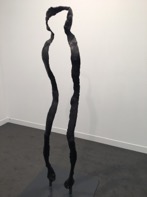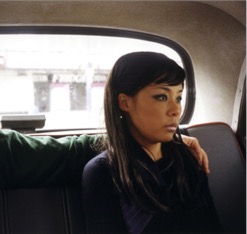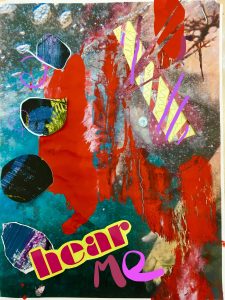The work of Jenny Holzer has already overcome the concerns raised by the idea of changing work to fit scale – moving from small stickers on parking meters to big enough to out size Blenheim Palace. Holzer uses a range of technology to ameliorate the transformation. Small slogans appear in a series of images on stickers, posters and t-shirts using printing techniques. Holzer uses Electronic signs LED that circulate the maxims from her truism series. She has used LED in her work since 1982. The methods of presenting the aphorism are generally vehicles used for public information. Holzer recognises that and subverts that to call attention to her art. The texts are often subversive and denouncing of power and inequality which also speak of importance and size. The biggest of the signs are projected by lights onto the facade of the palace at night. This is such a powerful and moving sight. the maxims are so powerful and moving. the method of showing the message so large it cannot be ignored
Author Archives: Caroline Perkins
Caroline Perkins: Task 11 Summerise My Blog
The whole process of writing a blog has been a new experience for me – I really struggled at the beginning to find my way around the word press blog system, that was just the technical part. I had to learn the discipline of condensing my thinking into a few words. I did not find that easy. I also struggled with the idea of exhibiting my work online, what would people think of my content? was it good enough? the process has been a steep learning curve. The most difficult task for me was task 7 reading, summarising, and comparing two articles in such a short word count. Unfortunately I went way over the word count on that task. The task I enjoyed most was consuming a book. I read more about the artist Tracey Emin, it really helped me to appreciate her work and discover what motivates her. I have found the whole process illuminating and I am very grateful for the variety of tasks and the opportunity to meet all the tutors through the process
Caroline Perkins: Task 9
I chose a picture of an exhibition of Jenny Holzers work, her work sits within the theory of semantics and feminism. I use slogans that represent how I feel about my position as a woman therefore I identify strongly with Holzers work. Jenny Holzer uses language as art. art as language has been debated over time looking at the theory of semiotics and the visual as language. Holzer uses the semantics, the meaning of the words in the context of a random sign in a poster on a subway wall or using an anonymous information system of LED lights takes the lexicon of the words and asks the audience to engage with the phrase. The meaning of the phrase is brought to the work by the viewer and their own position in the culture. Also, her work can be viewed from a position of Feminist theory. Jenny is speaking in a language made and developed by the patriarchal society and meaning can be interpreted by men and women in completely different ways. Jenny would listen to the debate of the general public as they discuss the work found pasted on walls in public places.
Caroline Perkins: Task 10, Hear Me!
Dawning Day,
Sharp Knives Marching
Cold
Swimmers Shouting
Rain Sky
Hear Me, Caroline Perkins
This work represents my practice in so much as there are many techniques I have started to develop and use in the making of my work. I have started to insert popular slogans and slogans that I resonate with from my feminist position. I am also experimenting with printing using the technique to deliver a more randomizing effect which places me at a distance from the piece. During the workshops I was introduced to the process of intercutting, which I feel helps me to move into and through my work to access and discover further ideas, working from the negative and positive spaces in the work using edges to define past and future. I have found looking into the work of Jenny Holzer Caes Oldenburg, Ilya and Emilia Kabakov. these artists have expanded my views of the authenticity of adding words and other artefacts to my work. I have chosen the 10 words for their visual imagery it is a verse from a poem I have written to describe the context of the original photo.
Caroline Perkins: Task 7
1 Leo Steinberg “from other criteria”. (Charles Harrison, 1992) Steinberg talks about a shift in the picture plane from the “old Masters practice of using of devises to draw attention to the art. Steinberg talks about development in this practice using the term flatbed picture plane which started in the 1960’s it changes the way a picture is represented in relation to the vertical nature of the human view point, which Steinberg calls world space. He cites Richard Rauschenberg as the first proponent of this style of seeing. A clear example of this would be 1955 when Rauschenberg smeared paint on his own bed and up righted it against a wall. Steinberg says, “The flatbed picture lends itself to any content that does not evoke a prior optical event`” this development refers to the difference in context between now and in the middle ages. A picture can now be conceived as an image of an image no longer an image of worldview.
2 Richard Serra from “The Yale Lectures” (Charles Harrison, 1992) This lecture was in response to a ruling made against Serra where he cited that a removal of a piece of work from its site-specific place was an unjustifiable suppression of the right to freedom of speech – an act of censorship.
Serra stated that the specificity of the site oriented works is depended on and inseparable from their location. (Charles Harrison, 1992) therefore, removing the piece was tantamount to destroying it as it could not be recited. The specificity of site –oriented works implies that they are conceived for dependent on and inseparable from their location (Charles Harrison 1992). In 1989 the piece tilted arc was removed from the federal Plaza in NYC. Serra talks of the difference between sculpture being the development of a piece by using material brought together to create a work where the difference between site specific is that the material should be interdependent to the location not separate from it this was new thinking in that time in 1990.
Steinberg explains that as Rauschenberg subverts the picture planes he also is shaking up the “art connoisseurs” position as the proponent of good taste and aesthetics, the self-appointed keepers of commercial success for artists therefore a representation of authority. This links to Serra who talks about commerce as meeting consumerist needs. He says that an artist can stand outside the submission to authority by making work that is not sponsored by corporate, or political manipulation by making work that is not commercial. Serra suggests that site specific works that are made for a specific location and don’t lend themselves to be sold onto another location suffer from lack of commercial value.Therefore, is not submitting to the authority of commerce.
If artefacts do not accord with the consumerist needs of people if they don’t submit to exploitation and marketing strategies they can be voted ad hoc into oblivion. In Rauschenberg’s case, he was able to move the thinking forward which made way for a wider range of artefacts to enter into the commercial art world.
Charles Harrison, P. W., 1992. Art in Theory An anthology of Changing Ideas. 2nd Edition ed. Oxford: Blackwell.
Caroline Perkins: Task 8 Appropriation
Task 8: Appropriation of an Image
I chose a piece of contemporary art, by artists: Ida Tursic and Wilfried Mille the work is a painting of Bettie Page a famous pin up girl from the fifties. I included mono printed text onto a photograph of the painting “look what you made me do”. this gives a different meaning to the painting of a pin up a commentary on her sexual appeal.
Caroline Perkins: Task 6, Modes of Practice
Task 6
Modes of Practice,
I start with a sculptural form, a 3D design or a found object, develop a motif as a metaphor, linking to my life experiences. I will explore the sculptural element so that it stands alone as an artefact . I then develop meaning from the form and represent that as a 2D image on the surface of a pre-treated photographic canvas. The image selected will have meaning through its context within the framework to the sculptural form. which infuses the 2D with a personal autobiographical context. Colour onto the canvas through the printing medium using a range of techniques to obscure the image on the photographic canvas. The resulting 2D work remains in a flatbed style where it doesn’t represent the real world there is intentionally no meaning to any accidental depth of field, no top or bottom no right way up. I need to obscure my own autobiography with paint in order to remain private and yet to reveal enough elements to enable a viewer to identify the everydayness of troubles that fall on us all like erratic’s falling from an ice glacier. The randomness of unasked for tragedies. Throughout the entire process the made artefact remains hidden in plain sight, a representational metaphor, a palimpsest to cover and curate my own work. Then to daringly challenge myself to expose more of myself and overlay the work with text that has meaning for me.
Caroline Perkins: Task 5 Art in the Flesh
The digital reproduction of Anslem Kiefer’s work cannot prepare anyone for the experience of seeing these paintings in the flesh.
I first saw the work of Anslem Kiefer at the French Pompidou Centre, Paris, 2016, I was awestruck by the emotion generated by the pieces, particularly, Für Paul Celan: Aschenblume, 2006. I felt the scope and magnitude of the emotion in the work instantly .
The sheer size of the work is the first thing that I found thrilling, I could stand at a distance from the painting and view it as a real view into a bleak and devastated world as if I had seen everything happen from a window. I moved toward the painting and felt like I was going to step inside, be immersed in the snow and ash coated soil, the cold bleakness of a post war, post holocaust world. Kiefer says “Art is difficult….,” “It’s not entertainment.”.
I was totally absorbed by the materials used, mud, ash and books. The fact that material was coming away from the work falling onto the pristine gallery floor. This piece of work was a reflection on Paul Celan’s post Holocaust poetry. When standing in front of this magnificent work, the sense of the pain the suffering screams at you. Up close to the painting I became focused on individual brush strokes the placing of the burnt books, the enormity of the task became real in terms of the actual work that went into the piece.
Caroline Perkins: Task 4 An Exhibition
Task 4
Frieze London
This Year I went to the Frieze Fair Exhibition. it was exciting to encounter contemporary art in one place. It really helped me understand the depth and breadth of the art being produced. Seeing these works first hand and not on the internet or other digital representation made me see that there is no way you can really reproduce a work digitally and expect a viewer to experience it in the way it was made to be seen – to examine the mark making, and appreciate the reality of scale and colour.

I looked at varied ways in which artists are making art. All the exhibitions I had previously viewed were of historic art. At institutions such as the Tate and the Royal academy. My eyes were opened to the new possibilitie
s and artists I hadn’t previously come into contact with.
I was overwhelmed by the sheer size and number of exhibits on show, I couldn’t possibly give the pieces I engaged with as much time as I would have liked. However, it highlighted those galleries I might visit that held the kind of art I would like to see mo re of.
re of.
Caroline Perkins: Task 3 The Image Part (14)
This image is from a project called Part (14) which is made up of a series of self-portraits with a companion. The companion has been cropped out of most of the images, just leaving a trace of the person a suggestion that she is not alone. This picture evokes a feeling of sadness and acceptance, as if there is nowhere else for the subject to go, that the she would rather be anywhere than where she is. Nikki S Lee is portraying the subject with a faraway stare, gazing out of the frame, as if she has no care or love for the person who has their arm tentatively around her. Nikki S Lee can persuade you into believing something that may or may not be true (Hamilton, 2001) There is a tense aspect to the body language as she looks uptight, she has positioned herself far away from the person in the cab.
When Nikki was interviewed by Phil Lee for a piece in Chicago Art Journal, he questioned the apparent detachment of her gaze asked if it was intentional, she replied that it wasn’t. “I am easily detached from things around me and maybe that inclination was what was revealed.” Lee, 2008)

Nikki S Lee
Hamilton, W. (2001). SHOPPING WITH — Nikki S. Lee; Dressing the Part Is Her Art. [online] Nytimes.com. Available at: http://www.nytimes.com/2001/12/02/style/shopping-with-nikki-s-lee-dressing-the-part-is-her-art.html [Accessed 20 Oct. 2017].
Lee, P. (2008). Indefinite “Nikkis” in a World of Hyperreality: An Interview with Nikki S. Lee. Chicago Art J 18 2008, [online] 18(Fall 2008), p.76. Available at: https://kuvisualculture.files.wordpress.com/2011/03/2f7.pdf [Accessed 20 Oct. 2017].





